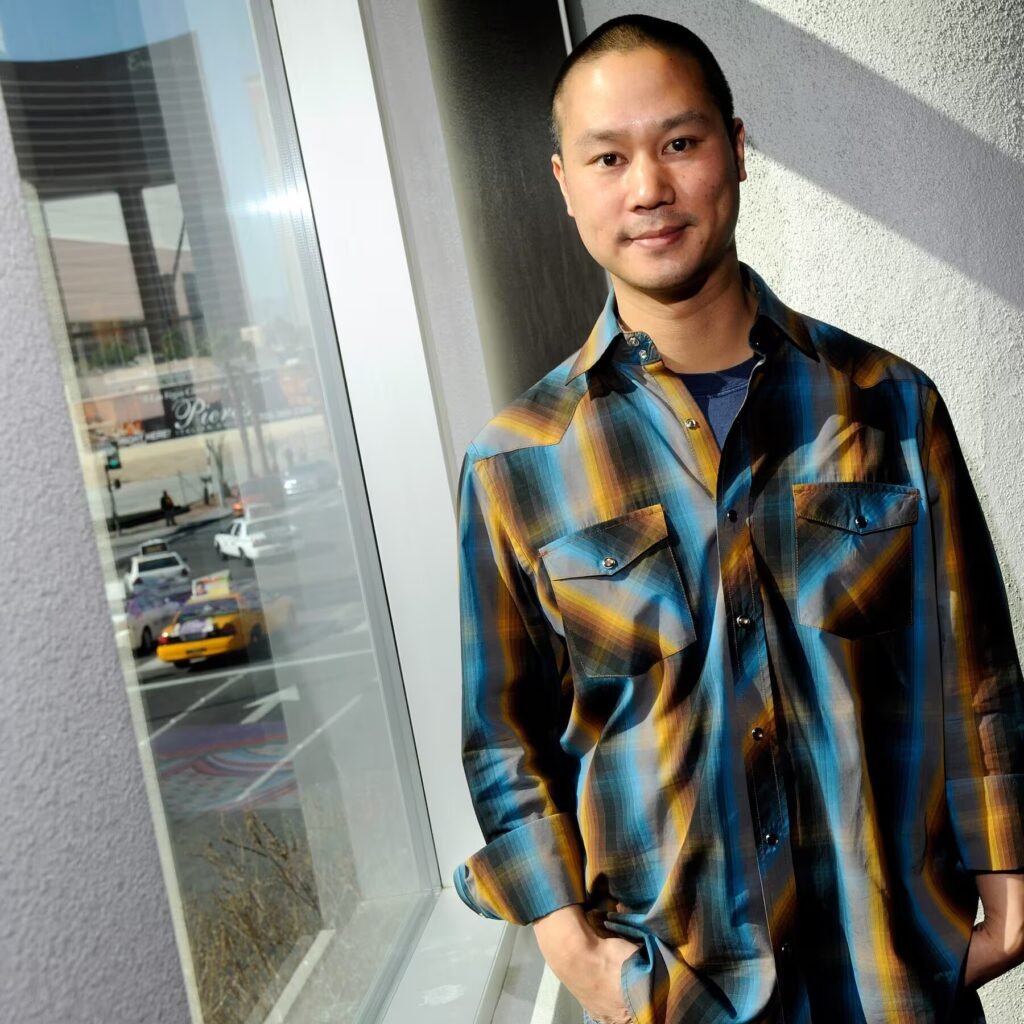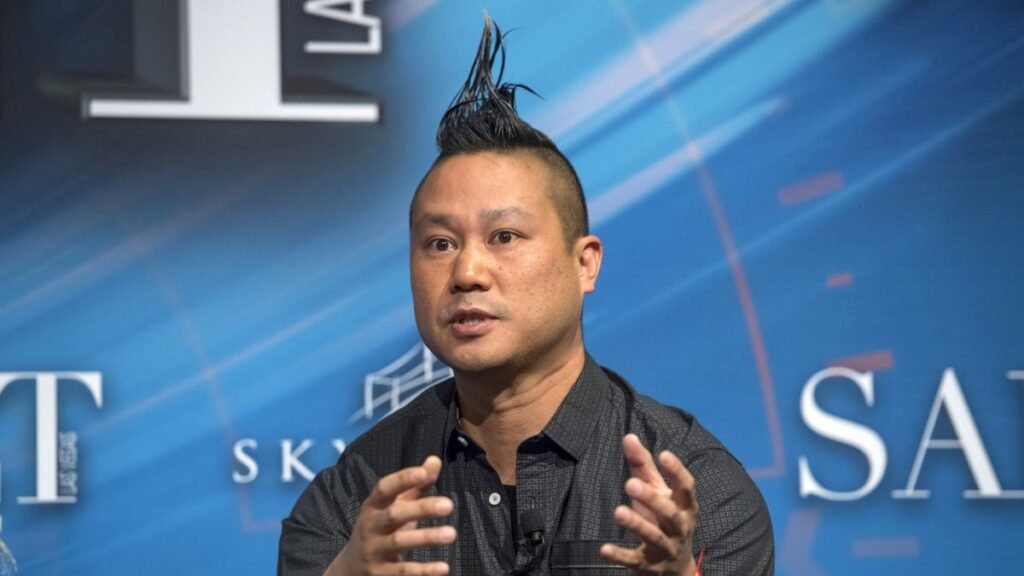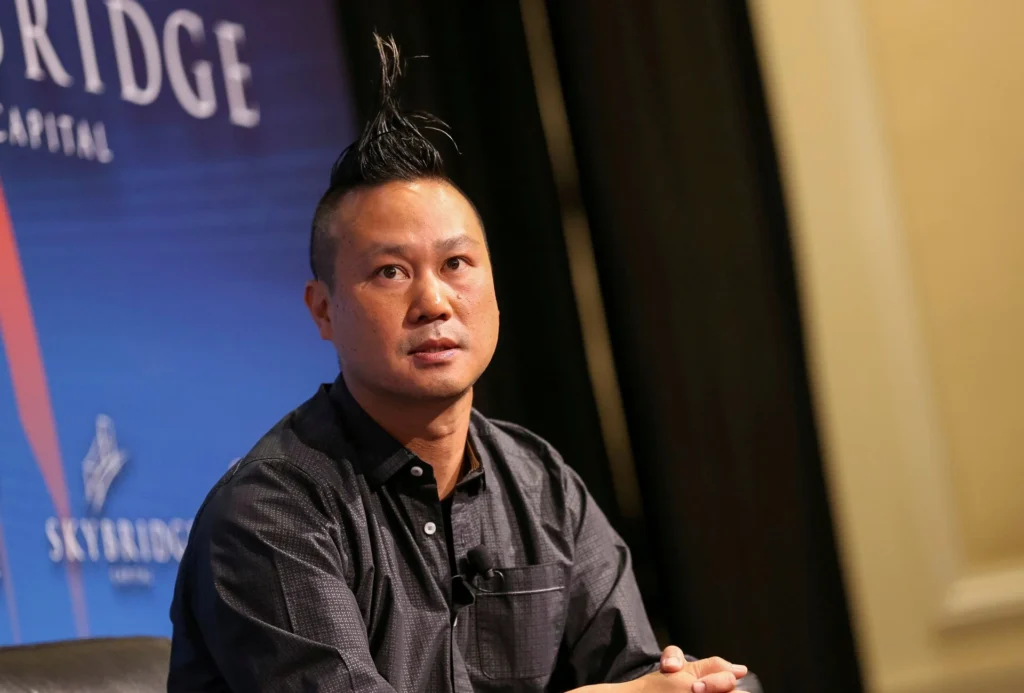Tony Hsieh Then and Now
Tony Hsieh Then
Tony Hsieh, born on December 12, 1973, in Illinois, experienced a significant shift in his early life when his family relocated to California shortly after his birth.
His parents, Richard and Judy Hsieh, were Taiwanese immigrants who met while studying at the University of Illinois.
This multicultural background influenced Hsieh’s perspective and approach to life.
Growing up in the Lucas Valley area of Marin County, California, Hsieh was raised in a nurturing environment, with his mother working as a social worker and his father employed as a chemical engineer at Chevron Corp.
He was the eldest of three boys, with two younger brothers, Andy and Dave, and his childhood experiences in this supportive family setting laid the groundwork for his future entrepreneurial spirit.
Hsieh attended the Branson School, where he began to cultivate his interests in business and technology.

He later graduated from Harvard University in 1995 with a degree in computer science.
His time at Harvard proved to be formative, as he not only excelled academically but also engaged in entrepreneurial ventures.
One notable experience was managing the Quincy House grill, where he sold pizzas to fellow students.
Related Article: Steve Chen Then and Now
This job not only honed his business acumen but also introduced him to future business partner Alfred Lin, who would later become the chief financial officer and chief operating officer of Zappos.
After completing his degree, Hsieh joined Oracle Corporation, but his desire for entrepreneurship soon led him to leave the corporate world after just five months.
He then co-founded LinkExchange, an advertising network that marked the beginning of his journey in the tech industry and set the stage for his later successes with Zappos.
Related Article: Jawed Karim Then and Now
Tony Hsieh Career
LinkExchange
In 1996, Tony Hsieh began conceptualizing LinkExchange, an innovative advertising network, alongside his college classmates Sanjay Mandan and Ali Partovi.
The core idea behind LinkExchange was to create a platform that allowed members to advertise on each other’s websites, thereby increasing their visibility and reach.
In exchange for displaying LinkExchange banner advertisements on their own sites, users could promote their content to a broader audience.
This reciprocal advertising model was a pioneering approach at the time, leveraging the burgeoning internet landscape to create a community-driven platform for website promotion.
Related Article: Chad Hurley Then and Now
The launch of LinkExchange in March 1996 marked a significant milestone in Hsieh’s career.
As the CEO, he took an active role in building the company from the ground up.
One of their first strategies was to directly email webmasters to pitch the concept, a method that proved effective in attracting early clients.
Within just 90 days of its launch, LinkExchange experienced exponential growth, boasting over 20,000 participating web pages and achieving more than 10 million banner ad displays.
Related Article: Robin Li Then and Now
This rapid expansion illustrated the demand for innovative online advertising solutions and showcased Hsieh’s ability to capitalize on emerging market trends.
By 1998, LinkExchange had evolved into a formidable player in the online advertising space, amassing over 400,000 members and rotating 5 million ads daily.
This remarkable growth attracted the attention of major tech companies, and in November 1998, LinkExchange was sold to Microsoft for an impressive $265 million.
Hsieh’s strategic vision and entrepreneurial acumen paid off handsomely; he personally netted $40 million from the sale, solidifying his reputation as a successful entrepreneur and paving the way for his subsequent ventures, including his legendary role in transforming Zappos into a leading online retailer.
Related Article: Lei Jun Then and Now

VentureFrogs
Following the successful sale of LinkExchange to Microsoft, Tony Hsieh turned his entrepreneurial spirit toward a new venture by co-founding Venture Frogs, an incubator and investment firm, with his business partner Alfred Lin.
The unique name “Venture Frogs” came about through a playful dare; a friend of Hsieh’s promised to invest everything she had if they adopted the quirky name, and the duo decided to accept the challenge.
Although they had not seen any monetary investment from her as of 2011, the name stuck and became emblematic of their adventurous approach to business.
Related Article: Lei Jun Then and Now
Venture Frogs focused on identifying and nurturing a diverse array of technology and internet startups, reflecting Hsieh’s vision for innovation and growth in the tech sector.
Among their notable investments were companies such as Ask Jeeves, OpenTable, and Zappos.
This strategic involvement in various startups not only showcased Hsieh’s keen eye for promising ventures but also laid the groundwork for his pivotal role in Zappos, which would later become a defining success story in his career.
Related Article: Ma Huateng Then and Now
Zappos
In 1999, Tony Hsieh’s entrepreneurial journey took a pivotal turn when Nick Swinmurn pitched the concept of selling shoes online to Hsieh and his partner Alfred Lin. Initially skeptical, Hsieh almost dismissed Swinmurn’s voicemail.
However, the potential of the footwear market in the United States—valued at $40 billion, with 5% already being sold through mail-order catalogs—caught his attention.
Recognizing the opportunity, Hsieh and Lin decided to invest in Swinmurn’s vision through their firm, Venture Frogs.
This investment marked the beginning of Zappos, with Hsieh taking on the role of CEO just two months later. The company started modestly, reporting $1.6 million in total sales in its first year.
Related Article: Jack Ma Then and Now
However, under Hsieh’s leadership, Zappos experienced explosive growth, with revenues skyrocketing to $1 billion by 2009.
With no existing blueprint for selling shoes online, Hsieh focused on creating a seamless and reassuring shopping experience for customers.
To achieve this, Zappos implemented innovative policies, such as offering free shipping and free returns on multiple pairs of shoes, which helped build customer trust.
Hsieh also restructured the company to foster a culture of autonomy and self-organization, transitioning Zappos to a holacracy model without formal job titles in 2013.
Related Article: Ben Silbermann Then and Now
This approach reflected his belief in empowering employees, and the company became highly selective in its hiring process, accepting only about 1% of applicants.
Named after the Spanish word for shoes, “Zapatos,” Zappos quickly gained a reputation as one of the best companies to work for, as highlighted by Fortune magazine.
The company’s commitment to extraordinary customer service, competitive salaries, and a welcoming work environment set it apart in the retail industry.
Hsieh’s passion for poker also influenced his decision to relocate Zappos’ headquarters to Henderson, Nevada, and later to downtown Las Vegas, further embedding the company within a vibrant entrepreneurial ecosystem.
Related Article: Reid Hoffman Then and Now
The culmination of Hsieh’s efforts came on July 22, 2009, when Amazon announced its acquisition of Zappos.com in a deal valued at approximately $1.2 billion.
Hsieh’s financial success from the sale was substantial, reportedly netting him at least $214 million, not including earnings from Venture Frogs.
After 21 transformative years at the helm of Zappos, Hsieh retired as CEO on August 24, 2020, leaving behind a legacy of innovation, customer service excellence, and a unique corporate culture that would continue to influence the e-commerce landscape.
Related Article: Peter Thiel Then and Now
Tony Hsieh Now

Tony Hsieh’s life came to a tragic end on November 27, 2020, at the age of 46, when he died in a house fire while visiting family in New London, Connecticut, for the Thanksgiving holiday.
On the morning of November 18, he sustained injuries in the fire, but his identity was not disclosed immediately.
Reports indicate that Hsieh was either trapped in a pool shed during the incident or had barricaded himself inside, refusing to answer the door as the flames engulfed the structure.
The circumstances surrounding the fire have raised questions, leading to an ongoing investigation into its cause.
Hsieh’s untimely death was met with widespread shock and mourning across the business community and beyond.
Related Article: Andy Jassy Then and Now
Known for his innovative leadership at Zappos and his unique approach to corporate culture, Hsieh left an indelible mark on the retail industry and the entrepreneurial landscape.
His commitment to customer service, employee empowerment, and community-building transformed Zappos into a household name and set new standards in e-commerce.
Hsieh’s passing not only represented a significant loss to those who knew him personally but also to the countless individuals and businesses inspired by his vision and philosophy.
As the investigation into the fire continues, the legacy of Tony Hsieh remains a powerful reminder of his contributions to business and his enduring impact on the communities he touched.
Related Article: Stewart Butterfield Then and Now
Tony Hsieh’s Net Worth
Tony Hsieh was a prominent American entrepreneur, author, and venture capitalist, renowned for his transformative leadership at Zappos, which significantly shaped the e-commerce landscape, at the time of his untimely death in 2020, he had amassed a remarkable net worth of $850 million, reflecting his successful ventures and investments in the tech industry.
Related Article: Drew Houston Then and Now
FAQs
Tony Hsieh died from injuries sustained in a house fire on November 27, 2020. The exact cause of the fire is still under investigation.
At the time of his death, Tony Hsieh had an estimated net worth of $850 million, largely due to his successful ventures, especially with Zappos.
Tony Hsieh was the CEO of Zappos until his untimely death in November 2020. He had a significant impact on the company’s culture and success during his tenure.
Reports indicate that during the house fire, Tony Hsieh was either trapped in a pool shed or barricaded himself inside, leading to his inability to escape the flames.
Tony Hsieh suffered injuries in a house fire while visiting family for Thanksgiving, and he ultimately passed away from those injuries on November 27, 2020. His death was met with widespread shock and mourning in the business community.






























